
a) N, N-Dimethylaniline
Interpretation:
The structure corresponding to the systematic name N, N-Dimethylaniline.
Answer to Problem 48AP
The IUPAC names given for the
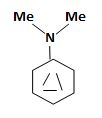
Explanation of Solution
The longest carbon chain containing the double bond to be chosen. Based on the name of the parent compound – the
The IUPAC names given for the amines have the following structures.
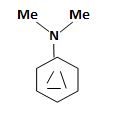
b) (Cyclohexylmethyl) amine.
Interpretation:
The structure corresponding to the systematic name (Cyclohexylmethyl) amine.
Answer to Problem 48AP
The IUPAC names given for the amines have the following structures.

Explanation of Solution
The longest carbon chain containing the double bond to be chosen. Based on the name of the parent compound – the alkene name ends with the suffix –ene. The chain is to be numbered from the end that gives the lowest number to the carbon in double bond. Substituents are to be numbered according to their positions in the chain and listed alphabetically. The position of the double bond is indicated by giving the number of the first alkene carbon before the name of the parent name. If more than one double bond is present, their positions are indicated with the suffixes -diene, -triene and so on. The isomer that has similar groups on each carbon on the same side of the double bond is called as the cis isomer. The isomer that has similar groups on each carbon on the opposite side of the double bond is called as thetrans isomer.
The IUPAC names given for the amines have the following structures.

c) N-Methylcyclohexylamine
Interpretation:
The structure corresponding to the systematic name N-Methylcyclohexylamine.
Answer:
The IUPAC names given for the amines have the following structures.

Explanation:
The longest carbon chain containing the double bond to be chosen. Based on the name of the parent compound – the alkene name ends with the suffix –ene. The chain is to be numbered from the end that gives the lowest number to the carbon in double bond. Substituents are to be numbered according to their positions in the chain and listed alphabetically. The position of the double bond is indicated by giving the number of the first alkene carbon before the name of the parent name. If more than one double bond is present, their positions are indicated with the suffixes -diene, -triene and so on. The isomer that has similar groups on each carbon on the same side of the double bond is called as the cis isomer. The isomer that has similar groups on each carbon on the opposite side of the double bond is called as thetrans isomer.
Conclusion:
The IUPAC names given for the amines have the following structures.

Answer to Problem 48AP
The IUPAC names given for the amines have the following structures.

Explanation of Solution
The longest carbon chain containing the double bond to be chosen. Based on the name of the parent compound – the alkene name ends with the suffix –ene. The chain is to be numbered from the end that gives the lowest number to the carbon in double bond. Substituents are to be numbered according to their positions in the chain and listed alphabetically. The position of the double bond is indicated by giving the number of the first alkene carbon before the name of the parent name. If more than one double bond is present, their positions are indicated with the suffixes -diene, -triene and so on. The isomer that has similar groups on each carbon on the same side of the double bond is called as the cis isomer. The isomer that has similar groups on each carbon on the opposite side of the double bond is called as thetrans isomer.
The IUPAC names given for the amines have the following structures.

d) (2-Methylcyclohexyl) amine.
Interpretation:
The structure corresponding to the systematic name (2-Methylcyclohexyl) amine.
Answer to Problem 48AP
The IUPAC names given for the amines have the following structures.
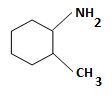
Explanation of Solution
The longest carbon chain containing the double bond to be chosen. Based on the name of the parent compound – the alkene name ends with the suffix –ene. The chain is to be numbered from the end that gives the lowest number to the carbon in double bond. Substituents are to be numbered according to their positions in the chain and listed alphabetically. The position of the double bond is indicated by giving the number of the first alkene carbon before the name of the parent name. If more than one double bond is present, their positions are indicated with the suffixes -diene, -triene and so on. The isomer that has similar groups on each carbon on the same side of the double bond is called as the cis isomer. The isomer that has similar groups on each carbon on the opposite side of the double bond is called as thetrans isomer.
The IUPAC names given for the amines have the following structures.

e) 3-(N, N-Dimethylamino)propanoic acid.
Interpretation:
The structure corresponding to the systematic name 3-(N, N-Dimethylamino)propanoic acid.
Answer to Problem 48AP
The IUPAC names given for the amines have the following structures.
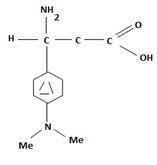
Explanation of Solution
The longest carbon chain containing the double bond to be chosen. Based on the name of the parent compound – the alkene name ends with the suffix –ene. The chain is to be numbered from the end that gives the lowest number to the carbon in double bond. Substituents are to be numbered according to their positions in the chain and listed alphabetically. The position of the double bond is indicated by giving the number of the first alkene carbon before the name of the parent name. If more than one double bond is present, their positions are indicated with the suffixes -diene, -triene and so on. The isomer that has similar groups on each carbon on the same side of the double bond is called as the cis isomer. The isomer that has similar groups on each carbon on the opposite side of the double bond is called as thetrans isomer.
The IUPAC names given for the amines have the following structures.
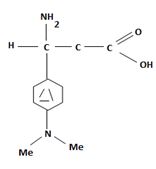
Want to see more full solutions like this?
Chapter 24 Solutions
ORGANIC CHEMISTRY W/OWL
- Protecting Groups and Carbonyls 6) The synthesis generates allethrolone that exhibits high insect toxicity but low mammalian toxicity. They are used in pet shampoo, human lice shampoo, and industrial sprays for insects and mosquitos. Propose detailed mechanistic steps to generate the allethrolone label the different types of reagents (Grignard, acid/base protonation, acid/base deprotonation, reduction, oxidation, witting, aldol condensation, Robinson annulation, etc.) III + VI HS HS H+ CH,CH,Li III I II IV CI + P(Ph)3 V ༼ Hint: no strong base added VI S VII IX HO VIII -MgBr HgCl2,HgO HO. isomerization aqeuous solution H,SO, ༽༽༤༽༽ X MeOH Hint: enhances selectivity for reaction at the S X ☑arrow_forwardDraw the complete mechanism for the acid-catalyzed hydration of this alkene. esc 田 Explanation Check 1 888 Q A slock Add/Remove step Q F4 F5 F6 A བྲA F7 $ % 5 @ 4 2 3 & 6 87 Click and drag to start drawing a structure. © 2025 McGraw Hill LLC. All Rights Reserved. Terms of Use | Privacy Ce W E R T Y U S D LL G H IK DD 요 F8 F9 F10 F1 * ( 8 9 0 O P J K L Z X C V B N M H He commandarrow_forwardExplanation Check F1 H₂O H₂ Pd 1) MCPBA 2) H3O+ 1) Hg(OAc)2, H₂O 2) NaBH4 OH CI OH OH OH hydration halohydrin formation addition halogenation hydrogenation inhalation hydrogenation hydration ☐ halohydrin formation addition halogenation formation chelation hydrogenation halohydrin formation substitution hydration halogenation addition Ohalohydrin formation subtraction halogenation addition hydrogenation hydration F2 80 F3 σ F4 F5 F6 1 ! 2 # 3 $ 4 % 05 Q W & Å © 2025 McGraw Hill LLC. All Rights Reserved. F7 F8 ( 6 7 8 9 LU E R T Y U A F9arrow_forward
- Show the mechanism steps to obtain the lowerenergy intermediate: *see imagearrow_forwardSoap is made by the previous reaction *see image. The main difference between one soap and another soap isthe length (number of carbons) of the carboxylic acid. However, if a soap irritates your skin, they mostlikely used too much lye.Detergents have the same chemical structure as soaps except for the functional group. Detergentshave sulfate (R-SO4H) and phosphate (R-PO4H2) functional groups. Draw the above carboxylic acidcarbon chain but as the two variants of detergents. *see imagearrow_forwardWhat are the reactions or reagents used? *see imagearrow_forward
- The two pKa values of oxalic acid are 1.25 and 3.81. Why are they not the same value? Show the protontransfer as part of your explanation. *see imagearrow_forwardасть Identify all the bonds that gauche interact with C-OMe in the most stable conformation of the above compound.arrow_forwardPredict the reactants used in the formation of the following compounds using Acid-Catalyzed dehydration reactionarrow_forward
 Chemistry for Today: General, Organic, and Bioche...ChemistryISBN:9781305960060Author:Spencer L. Seager, Michael R. Slabaugh, Maren S. HansenPublisher:Cengage Learning
Chemistry for Today: General, Organic, and Bioche...ChemistryISBN:9781305960060Author:Spencer L. Seager, Michael R. Slabaugh, Maren S. HansenPublisher:Cengage Learning
